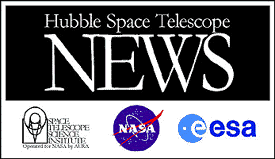 PRESS RELEASE NO.: STScI-PR98-01
PRESS RELEASE NO.: STScI-PR98-01
 PRESS RELEASE NO.: STScI-PR98-01
PRESS RELEASE NO.: STScI-PR98-01
CONTACT:
Ray Villard
Space Telescope Science Institute, Baltimore, MD
(Phone: 410-338-4514)Michael Hauser
Space Telescope Science Institute, Baltimore, MD
(Phone: 410-338-4730)
Astronomers have assembled the first definitive detection of a background infrared glow across the sky
produced by dust warmed by all the stars that have existed since the beginning of time.
For scientists, the discovery of this "fossil radiation" is akin to turning out all the lights in a bedroom only to find the walls, floor, and ceiling aglow with an eerie luminescence.
The telltale infrared radiation puts a limit on the total amount of energy released by all the stars in the universe. Astronomers say this will greatly improve development of models explaining how stars and galaxies were born and evolved after the Big Bang.
The discovery reveals a surprisingly large amount of starlight in the universe cannot be seen directly by today's optical telescopes, perhaps due to stars being hidden in dust, or being too faint or far away to be seen.
The discovery culminates several years of meticulous data analysis from the Diffuse Infrared Background Experiment aboard NASA's Cosmic Background Explorer (COBE), which was launched in 1989. The difficulty in making the discovery is analogous to listening for a faint background hum in a shopping mall full of people talking, music, and other noises.
"This is another big step in bringing cosmology to a science based on observation as well as theory", said Michael Hauser of the Space Telescope Science Institute, Baltimore, MD, principal investigator on the Diffuse Infrared Background Experiment. Reporting the results at the meeting of the American Astronomical Society in Washington DC, Hauser added: "We set out to do this 23 years ago, and these results show it was worth it. Our discovery fulfills the third and final cosmology objective of the Cosmic Background Explorer mission".
The unexpected preponderance of far infrared light implies that many stars have "fallen between the cracks" in ultra-sensitive visible light probes of the distant corners of the universe, such as the Hubble Deep Field.
One possible explanation is that the universe is very dusty, with many stars hidden in blankets of dust. Alternatively, many stars may have been born in a flurry of activity in the very early universe but faded away at earlier times than yet reached with large telescopes.
In either scenario, the existence of hidden stars is revealed by telltale dust that absorbs and re-radiates their light at infrared wavelengths, and so a permanent record of their existence is encoded in the infrared background.
Data from two other instruments on the Cosmic Background Explorer have already yielded the precise spectrum and a detailed map of another cosmological fossil (first discovered in the 1960s), the microwave background radiation from the Big Bang.
But finding the infrared background was not easy. Unlike the cosmic microwave background, which at millimeter wavelengths outshines everything else in the universe, the infrared background is masked by infrared light from nearby dust in our Solar System, stars, and interstellar dust in the Milky Way Galaxy, and, for ground-based instruments, emission from the Earth's atmosphere and from the instrument itself. The COBE mission overcame the last two problems by observing from space using a small telescope and instrument cooled to within a few degrees of absolute zero.
The COBE science team began by using the Diffuse Infrared Background Experiment to scan half the entire sky once a week, over a 10-month period from Dec. 1989 to Sept. 1990 (simultaneously at 10 wavelengths from 1 micrometer to 240 micrometers).
Astronomers then modeled and subtracted the infrared glow from foreground objects in our Solar System, our Galaxy's stars, and vast clouds of cold dust between the stars of our Milky Way.
Solar System dust was fairly easy to identify in the data because its brightness changes from week to week as Earth orbits the Sun. The interstellar dust of our Galaxy was identified in the data because it has structure, and so looks different across the sky. Light from stars was removed using a detailed model based on counts of the many types of stars in the various parts of the Galaxy.
When infrared light from these sources was subtracted from the all-sky maps, the astronomers found a smooth background of residual infrared light in the 240 and 140 micrometer wavelength bands in "windows" near the north and south poles of the Milky Way, which provided a relatively clear view across billions of light-years.
Astronomers next plan to probe the early formation of stars and galaxies using infrared telescopes on new space missions such as the Space Infrared Telescope Facility, Wide Field Infrared Explorer, Next Generation Space Telescope, and the Far Infrared Space Telescope, and hope some day to make more infrared background measurements using instruments launched deep into the Solar System to escape the interplanetary dust.
For the original press release, link to
COBE's Infrared View Of The Universe
(HubbleSite - NewsCenter, PRC98-01, January 9, 1998).
![]() The Space Telescope Science Institute
is operated by the Association of Universities for Research in Astronomy, Inc. (AURA),
The Space Telescope Science Institute
is operated by the Association of Universities for Research in Astronomy, Inc. (AURA),
for NASA, under contract with the
Goddard Space Flight Center, Greenbelt, MD.
The Hubble Space Telescope is a project of international cooperation between NASA and the
European Space Agency (ESA).
![]() Updated: January 16 '98
Updated: January 16 '98
Best seen with MS Internet Explorer.
Back: ARVAL's Gallery (COBE's Infrared View Of The Universe)
Messages: